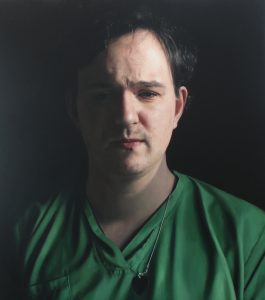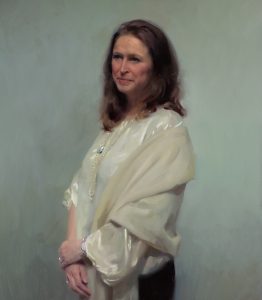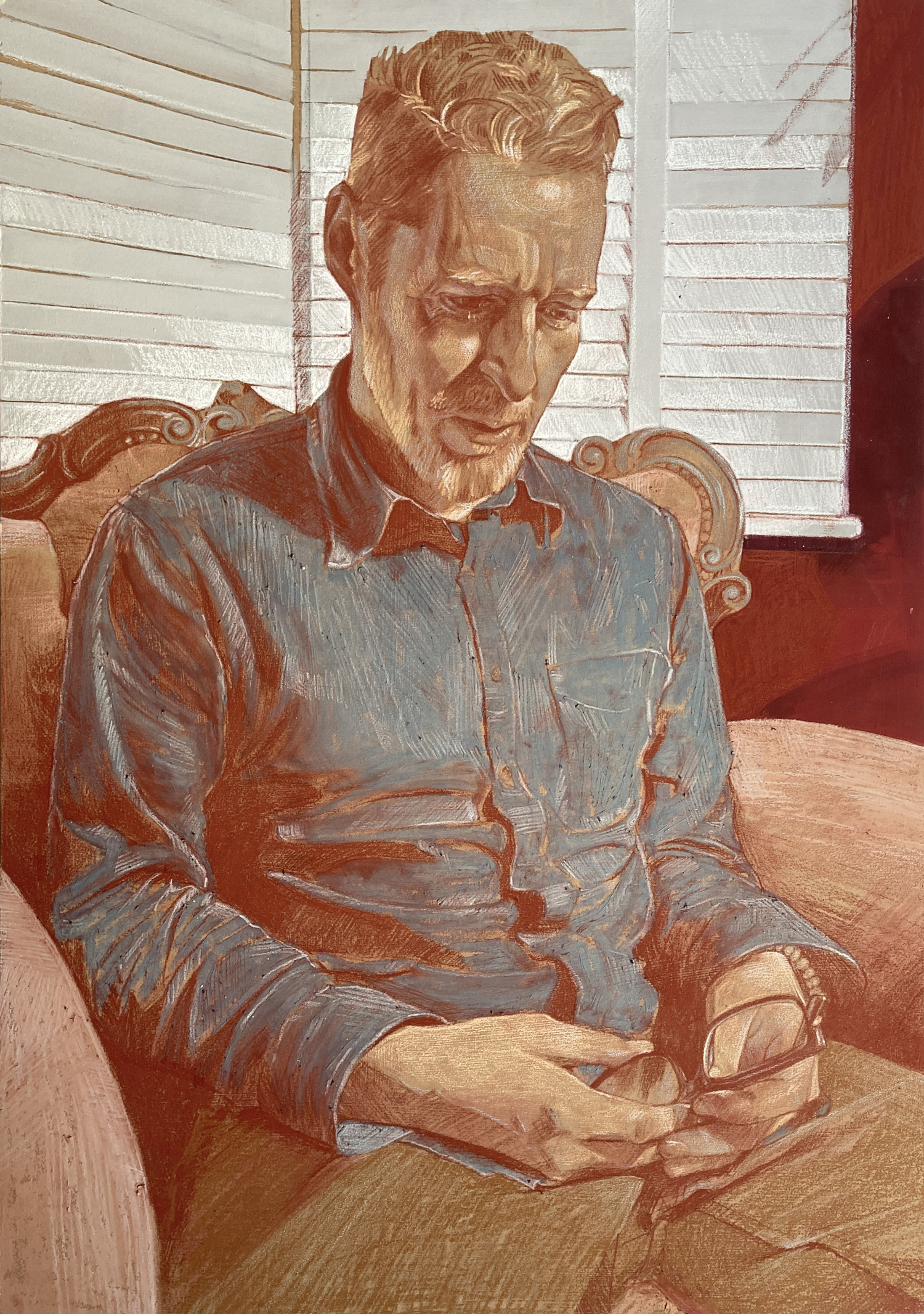Stories behind the Prize Winning Paintings of the Royal Society of Portrait Painters Annual Exhibition 2022
We hope you enjoy reading about the artists’ inspirations and experiences behind their prize winning paintings and are able to enrich your knowledge about their creative processes. The exhibition is on until Saturday 14th May, we hope you are able to visit and see these wonderful works in person!
-
The William Lock Portrait Prize: Tania Rivilis ‘Kupka’s Dog’

Tania said she was speechless to win the William Lock Portrait Prize and that it is a huge step for her in her art journey. I asked Tania to comment on her use of colour, as the yellow in ‘Kupka’s Dog’ is so vivid whilst being wonderfully balanced with the dark purples. Tania explains:
‘I reinterpreted Frantisek Kupka’s self portrait which is painted with absolutely magical vibrant yellow tones. In my expressive style I use gradients, connections, voids, and tense colour fields. In this painted I also wanted to depict Kupka’s love for Orphism (a branch of cubism which abstracts bright colours), the musicality of rhythms through the interpenetration of primary colours and the intersection of surfaces. That’s why the yellow colour field vanishes into the man’s garments, becoming part of his attitude.’
‘The dark fields of purple and black show the rhythm too. Although the portrait looks static, the rhythm of colours shows the storm of emotions inside the subject.’
Tania then spoke about the special bond we form with our pets, and how she goes about capturing the relationships between others in her work;
‘I’m amazed by the visual similarities between humans and their pets. Pets become our alter egos and we have indescribable bonds. Many of my favourite artists convey these bonds in their artworks, such as Valentin Serov’s ‘Count Felix Sumarokov-Elston’. Or Lucian Freud and his great love of dogs, and Kupka often elevated animals to the dignity of a person.
I make portraits in which there is always a reference to the other, because only in another’s gaze can the subject be assembled into a coherent image. Otherwise, a portrait would be an empty shell. I try to capture moments in which a person in relation to another person or creature discovers again and again the possibility of becoming whole.’
Tania commented on how friendly, professional and supportive the RP team have been, and explained that she is absolutely delighted to be a part of the exhibition.
-
RP Prize for the Best Small Portrait: Simon Davis ‘Taslima’

Paintings in consideration for the Best Small Portrait Prize cannot be larger than 38 x 30.5 cm (15 x 12 inches). I asked Simon about his choice of working on a small scale;
‘I often do smaller studies before starting larger works and this was one of those of my neighbour Taslima. However, sometimes these smaller works have a simplicity and directness that is lost in bigger paintings. In a large show like the RP annual exhibition, small works can be overlooked and are wrongly thought to lack the power and strength of larger work.’
Simon then discussed his process and tips for capturing someone’s likeness saying he incorporates photography within his process, treating photographs as information to be interpreted rather than copied. He says: ’my advice to portrait painters is to paint as much as you can as this is the only way to learn what does and doesn’t work for you.’
I also asked Simon which artists inspire him, he responded: ‘When I first started painting, the Newlyn school of Artists was very influential as a lot of them used the Square-Brush technique which I became fascinated with. I have a show ‘I Am Because You Are’ starting at Panter and Hall in London on the 11th May. This is an exhibition of 30 portraits of artists that have influenced me, ranging from illustrators, painters and comic artists as I have taken inspiration from all of them over my career.’
-
De Laszlo Foundation Award: Laura Hope Lloyd ‘Micheal’

Laura shared the story behind ‘Micheal’: ‘Micheal is a portrait artist who lives near me. I met him last year and he asked if I would sit for him. I agreed only if he would sit for me, which he was very hesitant about as he hates pictures of himself. Funnily enough, his slightly awkward nature was something I really enjoyed capturing. I’m really interested in portraying emotion and my sitters’ ‘inner world’. The reference photo for this piece was taken in his living room the day I sat for him, a perfect backdrop as I’m hugely inspired by ‘vintage’ aesthetics.’
I was struck by Laura’s effective use of a limited colour palette combined with her expressive mark-making techniques and asked her to comment of these stylistic choices:
‘I’ve only recently started embracing colour. I used to be really afraid of it, so I tried using colour but in a very limited way. I replaced my black pencil with a red pencil and then used a blue/grey for darker tones and a yellowy flesh colour for lighter tones. Finally I added other colours that complimented the piece. Although I studied Illustration, I learnt the most during the years I worked as a Memorial Artist – hand etching and painting designs and portraits onto gravestones. A lot of this work was in black and white, and I was taught in a very step-by-step way. Even though I work in colour now, I still use the same techniques I learnt there.’
‘My mark-making is very instinctual and I get my frustrations out about a piece through my marks. I also believe drawing can be just as exciting as painting so I like to show how alive drawing can be. I’ve been drawing ever since I can remember and there is an emotional quality that I haven’t quite found with paint yet. You can really dig into a piece quite aggressively with pencils and crayons, in a way that you can’t do with a brush.’
-
The Smallwood Architects Prize for Contextual Portraiture: Catherine Creaney ‘Care’

Catherine Creaney’s painting ‘Care’ is part of a larger series of paintings about carers. I asked Catherine to share the story behind the care worker in her painting and her inspiration behind the series more broadly:
‘This is Jordan Dennis, 30, a full-time care worker at a nursing home. In April 2021, he contracted Covid-19 whilst working with Covid patients, many of whom died. Jordan was extremely ill but passionate about his job, he wanted to get back as quickly as he could to be there for those at the nursing home. The portrait captured a moment when Jordan was struggling with the trauma of living through the pandemic, the toll of witnessing the deaths and illnesses of residents and the toll on his own health. This painting was my way of honouring all the care workers who tirelessly battled through the pandemic and is an acknowledgment of the mental and physical impacts it had.’
Catherines explained she started this series of paintings about carers before the pandemic. Their personal sacrifices and important role is something she’s wanted to honour in her work for many years after witnessing her mothers’ partner give up his role as a teacher and devote himself to her care when she was ill with MS for over 20 years. She marvelled at his willingness to take on the role and the sacrifices he made. Catherine has made this collection to honour carers’ work and to share their stories, drawing attention to their valuable and overlooked contributions to society.
I also asked Catherine about her favourite materials; ‘My favourite mediums are soft pastel and oil paints. Each has unique qualities that I enjoy using to create my portraits. I enjoy the myriad of techniques and approaches that oil offers, its versatility and unmatched ability to create realism. I find soft pastel is a more effortless medium which I use to create quick results and love the buttery texture. I couldn’t choose between the two and enjoy each equally!’
Catherine said it is a great honour and validation of her own work to get to exhibit alongside many of her favourite portrait painters who are members of the RP, and she is incredibly excited to have her work on display at Mall Galleries.
-
The Burke’s Peerage Foundation Award for Classically Inspired Portraiture: Frances Bell ‘Gillian’

Frances described the relationship between her and Gillian, and how she goes about capturing a sense of likeness in a portrait;
‘Gillian is a previous client of mine. I’ve painted her sons before, and this was a birthday present from her husband to her. I have also painted Gillian before for her mother, riding my horse sidesaddle! So we had a previous connection of working well on portraits.’
‘I’m a great believer in having sittings from life. I had Gillian for 2 long sittings. We chatted away all the time – I wanted her to look natural and engaged so conversation is vital to getting an expression that represents her character and vivacity.’
In ‘Gillian’ I was struck by Frances’ use of light and ability to create varied textured surfaces within her brushwork, and asked if she was able to comment on this further. Frances said:
‘I love fabric textures, almost as much as colours. This is a tonally narrow band of values – it’s all pale. I did however have silk which is strewn with highlights and soft wool which is entirely without highlights, it’s matte. So it was an enjoyable exercise chasing the opportunities to find excitement within the fabric.’
-
The Ondaatje Prize for Portraiture: Lantian D ‘Man and a Window’

Lantian described what draws her to portraiture, and spoke about the creative process behind ‘Man And A Window’:
‘I’m drawn to portraiture because of a natural tendency to reflect on our own being and to understand ourselves. To quote Lucian Freud, ‘Painters who deny themselves the representation of life and limit their language to purely abstract forms are depriving themselves of the possibility of provoking more than aesthetic emotion.’ But for ‘portraiture’ to exist in the 21st century, mimesis alone is not enough. My aim is poiesis.’
“Man and a Window” belongs to my series ‘Hortus Conclusus’ (Latin: Enclosed Garden), which is my journey as a modern individual in search of a soul. To paint is to understand the world through understanding oneself. My work is autobiographical and I extract and recompose models, my life and the world I’m in, transforming them into a deep well of meaning that if put into words, becomes misrepresented.
‘The Man’ in the piece was my lover at the time, and I was his ‘Window’. I was inspired by COVID lockdowns, millions isolated and confined. The pandemic has magnified causes of our ‘existential crisis’, and the way people are afflicted by debilitating feelings of insignificance, inadequacy and hopelessness. This social narrative, paralleled with the hopeless situation of my love affair and my own disturbed and confined upbringing, led to ‘Man and a Window’.
I also asked Lantian about her considered use of empty space and composition. She said she focuses on duality and borders, two essential conditions of being. In ‘Man and a Window’ she expressed opposite elements – individual versus mass, interior versus exterior, silence versus words, warm versus cold, passion versus calculation, liberty versus security and man versus window. To bring out these dualities, she exaggerated certain elements such as the windows’ reflection in the floor and eliminated other elements such as the man’s mouth to bring out impotence, vulnerability and silence, in turn emphasising ‘looking’ and the ‘window’.
Lantian was delighted to win the Ondaatje prize for the second time. Her series ‘Hortus Conclusus’ has 33 paintings, and she hopes to continue to develop the series and organise solo exhibitions of the project.
-
The RP Award: Nneka Uzoigwe ‘Narcissus’

Nneka’s self portrait depicts the story of Narcissus. Nneka explains that in the myth, Narcissus sees his reflection in a pool of water and, unable to tear himself away, he slowly dies. A daffodil ‘narcissus’ springs up in his place. In Nneka’s painting, Narcissus is a Dryad-like creature, half daffodil, half man. Nneka explains she has painted herself, symbolised as a pool of water by the swirling waves of her Hokusai robe, as she lowers thread from a golden pool to Narcissus’ reflection. His reflection entices him with the thread to pull him into the pool, with a humorous nod to the idea of an artist spending weeks starting into their own reflection when creating a self portrait.
When asked about her feelings about self portraits Nneka said ‘I love using myself as a model, as when I’m painting myself it feels like I have all the time in the world. It gives me a quiet space to day dream and further develop ideas onto the canvas as they happen. I spend a lot of time not painting and staring at the canvas. With self portraits, I paint them at home, as I tend to work on them every day for weeks, from dawn to dusk.’ She then said Dorothea Tanning, Antonio Mancini and George Watts are the artists she is most inspired by.
As for her advice to other portrait artists she says: ‘Don’t talk yourself out of flights of imagination, as naïve as they might seem, as they are in fact the seeds of individuality. Trust your technical ability to not just copy what’s in front of you, but create new ways of seeing.’
-
The Prince of Wales’s Award for Portrait Drawing: Thomas Arthurton ‘Portrait Study’

Thomas’ drawing has a great sense of reflection. I asked Thomas about the story behind the work: ‘Galina was an elderly woman I came to know in St Petersburg. As I drew she talked of life growing up in the former Soviet Union. She had experienced harsh conditions and this was reflected in her skin which showed an interesting radiance. I captured this by using my fingers to smudge the graphite and hatching, whilst taking the opportunity to create a loose, painterly and relaxed drawing. Galina maintained a strong faith in humanity which I found inspiring. Hers was one of the last drawings I undertook before I had to leave Russia.’
I also asked Thomas if he has any advice for emerging artists or recent graduates to which he said: ‘Draw, draw, draw and be free! I enjoy making quick drawings on the underground. You never know how long you have to capture the passenger’s most distinctive features before they are up and gone!’








